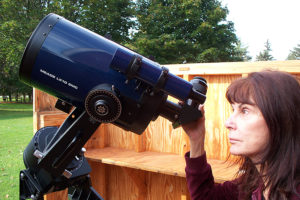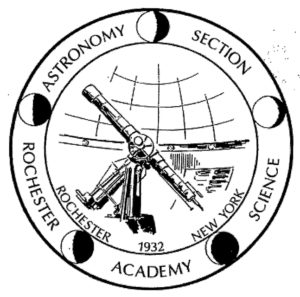At the Astronomy Section of the Rochester Academy of Science, looking up is more than a pastime
by Dee Sharples –
Many people aren’t aware of an organization in the Rochester area which offers people a friendly welcoming atmosphere, knowledge, fun, camaraderie and great snacks. It’s the Astronomy Section of the Rochester Academy of Science (ASRAS), and I’ve been a member of this group since I accidentally discovered its existence 20 years ago.
Although I had been interested in the stars and planets since I was 10 years old, I became what’s known as an armchair astronomer. My activities were limited to reading about astronomy, a subject I found both fascinating and complex.
When I went to my first ASRAS meeting, I wasn’t sure what to expect or if I’d fit in since my education didn’t include college level science, math or physics. Would I be able to converse with people who knew so much more than I did on the subject? Would I even be able to understand the presentation by the main speaker, a local college professor?
When I walked into the meeting located in a lecture hall at the Rochester Institute of Technology (RIT), I was immediately struck by the warm welcome I received – members introduced themselves, asked about my interests and made me feel right at home.

I was in awe that so many members actually owned telescopes and could observe objects like planets, galaxies and nebulae from their own backyards! Several months later when a couple members heard that I was interested in learning how to use a telescope, they offered to teach me. That’s when I became hooked on observational astronomy and my plan was to purchase my own telescope as soon as I gained sufficient knowledge and experience. Although owning a telescope was by no means a prerequisite for enjoying astronomy, it soon became my passion to look at the wonders of the night sky through an eyepiece – just me, my telescope and the soothing background sounds of a summer night.
If a beginner asked me if they should buy a telescope, I would recommend they first learn their way around the sky using a star map and their naked-eye. To successfully use my telescope, I found it helped tremendously to be able to identify the constellations and understand their seasonal march across the sky.
ASRAS was a smaller group when I joined but membership grew and so did their goals, becoming more diverse and deeply involved in public outreach.
Meetings are generally held on the first Friday of the month from 7:30 – 9:30 pm. The November 3rd meeting will be at RIT in Gosnell Hall, Room A-300. Everyone is welcome – you don’t need to be a member to attend. Further details, as well as other astronomy information, can be found on the ASRAS website at www.rochesterastronomy.org.
The reasons people join ASRAS are as varied as their backgrounds. Some have very little knowledge of astronomy and want to learn more, while others are amateur or professional astronomers.
Some are interested in finding out more about “nearby” objects like the planets, sun and moon. Others like studying objects thousands or millions of light years away from Earth such as galaxies, variable stars and supernovae.
Many people enjoy astrophotography and are especially interested in the equipment and software used to create images. Others like to sketch what they see through their telescopes – craters on the moon, planets or star fields.
Still others prefer interaction with people through public star parties held at area parks and the Strasenburgh Planetarium.Many enjoy working with children and sharing their knowledge at Scout meetings and library and summer programs. And there are those who just like to look up and enjoy the beauty of the night sky without any special equipment.

Each may have a different specific interest, but they all share a common love of astronomy, and many are not only willing, but eager, to share their knowledge and talents with others.
One ASRAS social event is RocheStar Fest, the annual astronomy weekend. It’s held at their dark-sky observing site in Ionia, NY and includes Friday evening tent set-up and games such as Astro-Jeopardy and music trivia and a Saturday packed with talks and demonstrations, children’s activities, a silent auction, door prizes, barbecue dinner and a main speaker. It’s always a plus if the nights are clear and the telescopes can be opened for observing.
The ASRAS mission statement sums it up: “Our mission is to share our passion for, and joy in, astronomy by providing fellowship, education and extraordinary observational experiences to members of our organization and the community.”